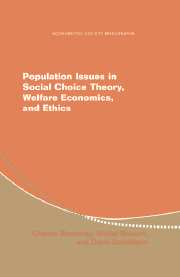Book contents
- Frontmatter
- 1 Introduction
- 2 Measurement of Individual Well-Being
- 3 Welfarist Social Evaluation
- 4 Fixed-Population Principles
- 5 Population Principles
- 6 Characterizations and Possibilities
- 7 Uncertainty and Incommensurabilities
- 8 Independence of the Existence of the Dead
- 9 Temporal Consistency
- 10 Choice Problems and Rationalizability
- 11 Applications
- References
- Author Index
- Subject Index
10 - Choice Problems and Rationalizability
Published online by Cambridge University Press: 05 January 2013
- Frontmatter
- 1 Introduction
- 2 Measurement of Individual Well-Being
- 3 Welfarist Social Evaluation
- 4 Fixed-Population Principles
- 5 Population Principles
- 6 Characterizations and Possibilities
- 7 Uncertainty and Incommensurabilities
- 8 Independence of the Existence of the Dead
- 9 Temporal Consistency
- 10 Choice Problems and Rationalizability
- 11 Applications
- References
- Author Index
- Subject Index
Summary
Part A
Because many policy decisions have population consequences, it is natural to use population principles to guide them. These decision problems are, in most cases, choice problems: one or more options must be selected from a set of feasible alternatives. Examples are decisions involving the allocation of funds to population-control programs or to prenatal care.
The maximizing approach to solving choice problems consists of two steps. First, a social ordering with ethically appropriate properties is identified, a task that is the focus of the previous chapters. Once that is done, choices can be made by selecting the best feasible alternatives (provided that they exist) according to the ordering. The best alternatives in any feasible set are those that are ranked as at least as good as all feasible alternatives. There may be more than one best alternative and, in that case, all the best alternatives are ranked as equally good. For that reason, the actual choice may be any one of them.
Although this is a reasonable way to proceed, it excludes consideration of choice procedures that are not based on social orderings from the outset. In addition, it is natural to ask whether the focus should be on the choices themselves rather than on the social ordering. Requiring that all alternatives can be ranked may be too much to ask of a social decision procedure.
- Type
- Chapter
- Information
- Publisher: Cambridge University PressPrint publication year: 2005



